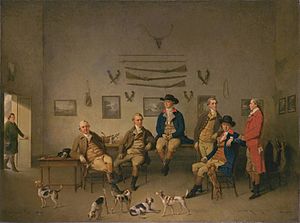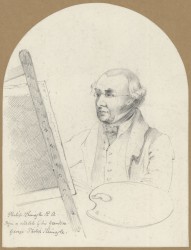Philip Reinagle facts for kids
Philip Reinagle (born in 1749 – died on November 27, 1833) was a famous English painter. He was known for his beautiful paintings of animals, landscapes, and plants. Philip was born in Edinburgh, Scotland. His father was a musician from Hungary. In 1763, Philip moved to London and became an artist. He later joined the Royal Academy, a very important art institution.
Contents
Becoming a Royal Artist
Philip Reinagle started studying art at the Royal Academy in 1769. He became a student of Allan Ramsay, a well-known painter. Philip helped Ramsay paint many portraits of King George III and Queen Charlotte.
Philip first showed his art at the Royal Academy in 1773. For a while, he mostly painted portraits. But painting the same royal portraits over and over became boring for him. So, around 1785, he decided to try painting animals instead.
Painting Animals and Landscapes
Philip became very good at painting animals. He was especially skilled at showing hunting dogs, like spaniels, and different kinds of birds. He also painted scenes with dead game.
In 1787, Philip showed a landscape painting called View taken from Brackendale Hill, Norfolk. After that, he started to exhibit more landscape paintings. He became an "associate" of the Royal Academy in 1787. This meant he was a recognized artist, but not yet a full member.
He finally became a full member, called an "academician," in 1812. To become a full member, he had to present a special painting. His painting was called An Eagle and a Vulture disputing with a Hyaena. He also often showed his art at another place called the British Institution.
Copying Famous Paintings
Philip Reinagle was also amazing at copying paintings by old Dutch masters. These were famous artists from the Netherlands. He copied their paintings of animals and landscapes so well that sometimes people thought his copies were the original artworks!
He also drew pictures for books. Some of his drawings were for a book about plants called Philosophy of Botany. But his best drawings for books were of dogs. These were for a book called Sportsman's Cabinet (published in 1803). Another artist named John Scott then made engravings from Philip's drawings.

Philip Reinagle passed away in Chelsea, London, on November 27, 1833. He was 84 years old. One of his drawings, called 'Fox-hunting the Death', is kept at the Victoria and Albert Museum.
Philip's Family of Artists
In 1771, Philip Reinagle married Jane Austin. They had many children, including nine daughters and two sons.
One of his sons, Ramsay Richard Reinagle, also became an artist. He painted in a similar style to his father. Another son, Philip, moved to Trinidad. There, he worked as a surveyor and helped design and build two important cathedrals: Holy Trinity Cathedral and the Cathedral Basilica of the Immaculate Conception.
Some of Philip's daughters also became artists. Charlotte Reinagle and Frances Arabella Reinagle showed their work at the Royal Academy and the British Institution. They even found a clever way to make money by copying parts of famous paintings. They would quickly paint details from valuable artworks that were on loan to the British Institution. They claimed to have a three-day cycle: paint on the first day, sell on the second, and spend the profits on the third! Other siblings, Oriana Georgina, Harriet, and Philip Reinagle the younger, also exhibited their own artworks.
See also
 In Spanish: Philip Reinagle para niños
In Spanish: Philip Reinagle para niños



